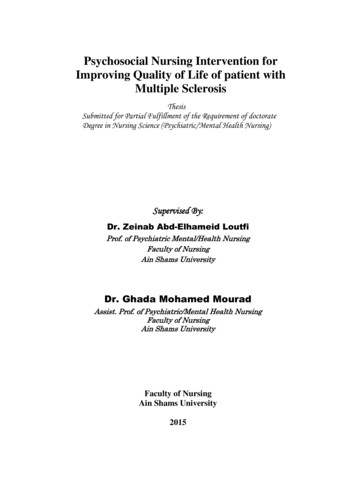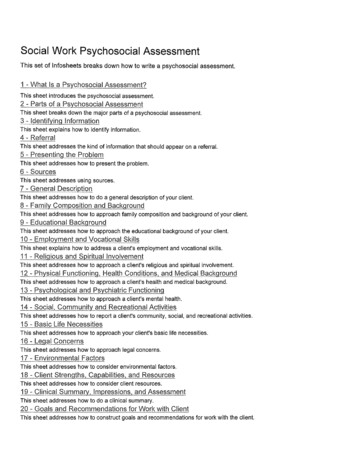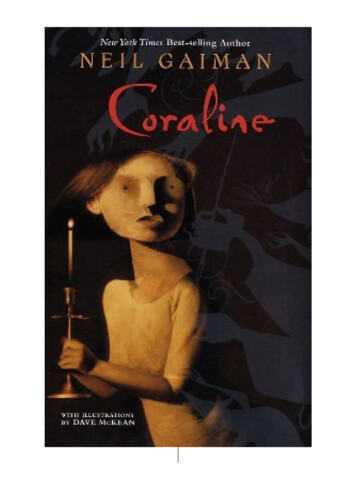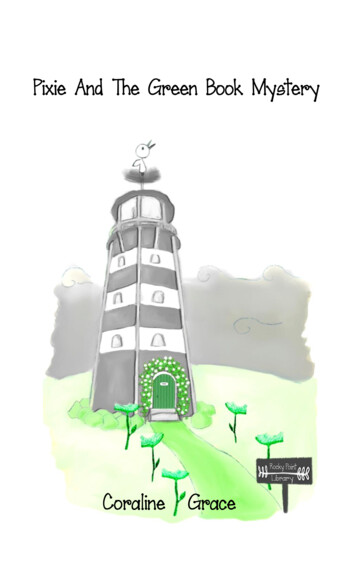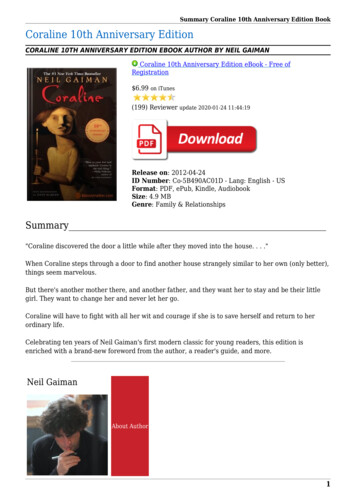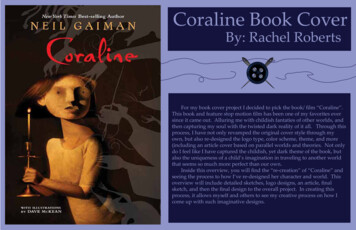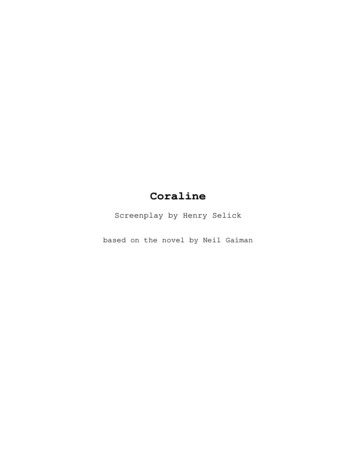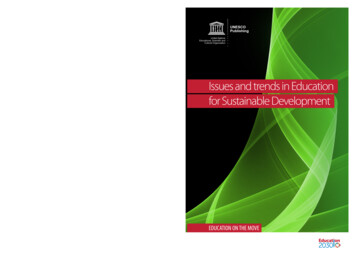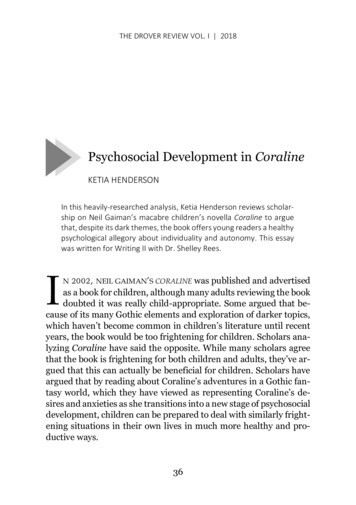
Transcription
THE DROVER REVIEW VOL. I 2018Psychosocial Development in CoralineKETIA HENDERSONIn this heavily-researched analysis, Ketia Henderson reviews scholarship on Neil Gaiman’s macabre children’s novella Coraline to arguethat, despite its dark themes, the book offers young readers a healthypsychological allegory about individuality and autonomy. This essaywas written for Writing II with Dr. Shelley Rees.IN 2002 , NEIL GAIMAN’S CORALINE was publishedand advertisedas a book for children, although many adults reviewing the bookdoubted it was really child-appropriate. Some argued that because of its many Gothic elements and exploration of darker topics,which haven’t become common in children’s literature until recentyears, the book would be too frightening for children. Scholars analyzing Coraline have said the opposite. While many scholars agreethat the book is frightening for both children and adults, they’ve argued that this can actually be beneficial for children. Scholars haveargued that by reading about Coraline’s adventures in a Gothic fantasy world, which they have viewed as representing Coraline’s desires and anxieties as she transitions into a new stage of psychosocialdevelopment, children can be prepared to deal with similarly frightening situations in their own lives in much more healthy and productive ways.36
HENDERSON PSYCHOSOCIAL DEVELOPMENTMany scholars point out Coraline’s obvious boredom and desirefor attention at the beginning of the story, as well as her attempts toset herself apart as an individual; they argue that these things aresigns that she is in the middle of a transition from one stage of psychosocial development to another. Coraline’s boredom can be seenin her dissatisfaction with having to stay inside when it rains and herrepeated attempts to get her parents to pay attention to her or giveher interesting things to do (Gaiman 4). Karen Coats explains thatUp to a certain point, the developing child is so entangled with themother that his or her desires are not perceived as separate, atleast on the part of the child. When a child develops the capacityto be bored, it is a signal that he or she is in a transitional state, astate where he or she is developing a separate sense of self, a needto assert his or her desires over and against the desires of themother. (86)Prior to this transitional state, children rely on their parents to satisfy all their needs and wants, which is why Coraline initially goes toher parents seeking relief from her boredom. Coraline’s parents areclearly expecting her to be more independent, though; they give hersuggestions for things to do that don’t involve them, like reading,watching a movie, or playing with her toys. They even both requestthat she go “pester” or “bother” Miss Spink and Miss Forcible andleave them alone to work (Gaiman 4, 16). But despite her desire forattention from her parents, Coraline can also be seen trying to setherself apart as an individual with her own desires, like when sheasks her mother to get her green gloves for school, saying that she“could be the only one” to have green gloves instead of the greygloves that everyone else has (21). Kara Keeling and Scott Pollardalso point to Coraline’s criticism of her father’s cooking and refusalto eat it as an attempt to be more independent (5), and AubaLlompart Pons points out Coraline’s frustration with her neighborsrepeatedly getting her name wrong, “depriving her of the originality37
THE DROVER REVIEW VOL. I 2018of her name to give her a more common one” (“Reversing the Bildungsroman” 309). These things show that, while Coraline may beupset at not getting the attention from her parents that she got whenshe was younger and completely dependent on them, she is alsostarting to move on to a stage in her life where she has the desire tomake her own decisions and set herself apart from her parents andother people.Because Coraline appears to be transitioning into a new stage ofpsychosocial development, most scholars agree that the other worldshe ends up in is a representation of her desires and anxieties aboutgrowing up. While the action of walking through the door appearsto be an “act of defiance against adult prohibitions” (Gooding 397),since the old man upstairs had already warned her not to go throughit (Gaiman 14), the other world that it takes her to is full of reminders of her desire to remain dependent on her parents. The othermother in particular seems to represent Coraline’s desire for hermother to satisfy all her needs and wants, and her fear that becoming independent of her mother would require losing her love and attention (Gooding 397). When Coraline first enters the other world,the other mother cooks for her and gives her interesting things todo, unlike her real mother (Gaiman 26-27). The other mother almost seems to read Coraline’s mind at some points and fulfill herwishes before she even voices them, something that Coraline mayhave expected of her parents as a little child. Richard Gooding pointsout that these are uncanny elements—things that Freud describedas being unsettling because they seem to bring us back to childlikeways of thinking (392). Coraline isn’t initially bothered by thesethings, though. She seems happy to have parents whose attention isall on her. It isn’t until she realizes that the cost of staying in thisother world would be to have buttons sewn into her eyes that shebegins to be afraid (Gaiman 43). David Rudd compares the prospectof having buttons sewn into the eyes to the fear of being buried alive,which reminds us of being inside the mother’s womb, “somethingthat was once . . . home to us all, but which in later life can seem38
HENDERSON PSYCHOSOCIAL DEVELOPMENTanything but: a smothering, threatening environment” (6). Ruddalso describes this act as the other mother turning Coraline into adoll, one of her possessions (13). Coraline eventually discovers theghosts of the dead children that the other mother has already consumed and decides to challenge the other mother to a game whereshe will either find her parents and the souls of the dead children orstay with the other mother forever (Gaiman 82, 90). About this,Gooding says, “The ‘exploring game’ therefore becomes a test of Coraline’s capacity to surmount an infantile desire for permanent(re)union with the mother. . . . [I]t is more fundamentally a struggleagainst her own desire for dependency and identification. . . . [T]olose the game would be to accept perpetual childhood” (397-98). AsCoraline looks for her parents and the souls of the other children,the other world and everything in it start to become unformed. Coraline encounters the other Miss Spink and other Miss Forcible, whohave become fused together and contained in a sac, as well as theother father who is slowly losing his shape (Gaiman, 99, 108). Coatsargues that these images are meant to resemble fetuses and that theyrepresent both Coraline’s desire to be reunited with the mother andher fear of regressing to a point where she is completely one with themother and no longer an individual (88). Later, when Coraline hasrescued her parents and the souls of the dead children, she has topass through a corridor back to the real world, and when Coralinetouches the wall, it is described as being “hot and wet, as if she hadput her hand in somebody’s mouth” (Gaiman 133). Coats argues thatthis is meant to represent the process of being born and leaving thewomb, or, in Coraline’s case, being reborn (88).Coraline undergoes an obvious change by the end of the story,and most scholars argue that it is a positive change and a sign thatshe has moved forward into the next stage of psychosocial development, instead of regressing back into the former one. Because of herexperiences in the other world with the other mother, Coraline realizes the dangers of remaining dependent on her parents. If hermother and father were to satisfy all her needs and wants, she would39
THE DROVER REVIEW VOL. I 2018never have the opportunity to have her own desires (Coats 87). Shewouldn’t be able to shape her own identity and personality by finding ways to satisfy her desires on her own like she does with exploring, trying to get her mother to buy her green gloves, or choosing herown food (Howarth 75; Gaiman 21, 8). She realizes that she can’t bethe only thing that her parents care about, that they can’t satisfy allher desires, and that “To be totally all for someone, in fact, is to ceaseto exist, to be possessed (which is what the other mother offers)”(Rudd 9). The other mother and the unsettling Gothic elements thatsurround her end up serving the purpose of abjecting the motherfigure for Coraline and making her want to be independent from hermother, having realized that to be independent and able to go afterher own desires, she needs to be separated from her mother to a certain degree (Rudd 12). Coraline’s experiences in the other worldforce her to think for herself and survive on her own since her parents are not there to help her, and because of this she is able to cometo a better understanding of herself, as well as come to appreciate“the true and loving relationship between herself and her real parents” (Howarth 75). Gooding also points out that “Coraline’s returnfinds her more independent, more aware of her feelings, more emotionally and physically demonstrative, and more engaged with theworld” (400). This can be seen when she hugs her parents and MissSpink and Miss Forcible and also when she takes the time to learnthe name of the old man upstairs, Mr. Bobo, and have a conversationwith him (Gaiman 137, 159, 158). Pons explains that “the battle between good and evil, children and adults, which takes place in Coraline’s own home” is what “triggers the child’s endeavor to overcomeher initial feelings of alienation and understand her place in the family and the world” (“Reversing the Bildungsroman” 308). Because ofher adventures in the other world, Coraline comes to appreciate herreal family and her real home.Scholars argue that this story can be beneficial to children formany reasons. Elizabeth Parsons argues that by giving children aprotagonist they can relate to and then showing her facing her fears40
HENDERSON PSYCHOSOCIAL DEVELOPMENTand dealing with her problems in productive ways, Coraline teacheschildren how to be more resilient when facing their own difficult circumstances in life (130). She also argues that experiencing a varietyof emotions, including fear and sadness, within the safety of a workof fiction and seeing how the protagonist deals with those emotionshelps children prepare to deal with those emotions in more healthyways in real life (132). Coats argues that Coraline is similar to thetraditional fairy tale in that it is meant to do unconscious psychological work for children, giving them monsters and villains that theycan project their fears and anxieties onto and then showing themthat they can be overcome (78). Michael Howarth points out that,through Coraline, Gaiman teaches children that “growing up consists of many perilous moments that are threatening and risky, butare necessary nonetheless for our own maturity and personal development” (95). This message is especially obvious in the scene whereCoraline must retrieve one of the marbles containing the soul of adead child from the sac containing the other Miss Spink and theother Miss Forcible (Gaiman 99). Coraline almost talks herself intolooking elsewhere for the marbles so she doesn’t have to go anywhere near the sac, but she then realizes that she has to face herfears and look, or she may lose the game against the other mother.Pons also points out that Gaiman makes an obvious effort to depictthe child as a more psychologically complex character than mostchildren’s writers do (Good Seed 117). Gaiman doesn’t narrate thestory as though he knows more than Coraline (128); his knowledgeis limited to what Coraline knows, and Coraline is allowed to makeand fix mistakes without an adult narrator judging or admiring her(131). Because of this, children are able to read the story and maketheir own judgments about the events that take place in it (124).Coraline gives young readers a protagonist they can relate to:someone who is the same age as them and possibly going throughsimilar difficulties. Because Gaiman shows Coraline’s desires andanxieties, which young readers may share, through Gothic villains41
THE DROVER REVIEW VOL. I 2018and uncanny elements, children are able to relate to Coraline’s experiences on a deep, psychological level. They are able to experienceher fear, as well as her relief, and follow along as she overcomes herproblems. In the process, they are able to learn important lessons,but the lessons they take from the text are largely left up to them,allowing them to choose for themselves and be independent as Coraline is. Despite adults’ fears, Coraline is actually a perfect book forchildren who are in the process of growing up and coming to understand their own identities and place in the world. WORKS CITEDCOATS, KAREN. “Between Horror, Humour, and Hope: Neil Gaiman and thePsychic Work of the Gothic.” The Gothic in Children’s Literature:Haunting the Borders, edited by Anna Jackson, Karen Coats, and Roderick McGillis, 3rd ed., Routledge, 2013, pp. 77-92.GAIMAN, NEIL. Coraline. Illustrated by Dave McKean, 10th Anniversary Edition, Harper Collins, 2012.GOODING, RICHARD. “‘Something Very Old and Very Slow’: Coraline, Uncanniness, and Narrative Form.” Children’s Literature AssociationQuarterly, vol. 33, no.4, 2008, pp. 390-407.HOWARTH, MICHAEL. “Games and Challenges: Industry and Inferiority inCoraline.” Under the Bed, Creeping: Psychoanalyzing the Gothic inChildren’s Literature. McFarland, 2014, pp. 74-99.KEELING, KARA K., and SCOTT POLLARD. “The Key is in the Mouth: Food andOrality in Coraline.” Children’s Literature, vol. 40, 2012, pp. 1-27.PARSONS, ELIZABETH. “Images of Resilience: Children’s
Psychosocial Development in Coraline KETIA HENDERSON In this heavily-researched analysis, Ketia Henderson reviews scholar-ship on Neil Gaiman’s macabre children’s novella Coraline to argue that, despite its dark themes, the book offers young readers a healthy psychological allegory about individuality and autonomy. This essay was written for Writing II with Dr. Shelley Rees. N 2002, NEIL .
